Pasta con le Sarde is one of the most famous dishes from Sicilian cuisine. This traditional recipe combines the fresh taste of the sea with the aromatic flavors of the Sicilian countryside. Made with simple ingredients like fresh sardines, wild fennel, raisins, pine nuts, and breadcrumbs, it’s a true expression of Sicily on a plate.
The secret of a perfect pasta con le sarde lies in the balance of flavors: the sweetness of the raisins, the crunch of the toasted breadcrumbs, and the distinctive aroma of wild fennel. If you can’t find wild fennel, you can replace it with fennel tops and a pinch of fennel seeds.

Saffron and raisins give this dish its unique Middle Eastern touch, a reminder of Sicily’s long history of Arab influence. Traditionally, Spaghettoni or Bucatini are used to make this recipe.
Preparing pasta con le sarde is not difficult. The only real challenge is cleaning the sardines, but your fishmonger will usually do that for you. Once that’s done, you just need to make a simple soffritto with olive oil and onion, then add the remaining ingredients step by step.
In the end, you’ll get a flavorful pasta dish where the aroma of fennel, the sweetness of the raisins, and the freshness of the sardines come together beautifully. The result is one of the most iconic and delicious recipes in Sicilian cooking.
Ingredients

Prep Time: 20 Min | Cook Time: 20 Min | Serving: 4
- 350 g (12 oz) Spaghettoni (thick spaghetti) or Bucatini
- 250 g (9 oz) fresh sardines, cleaned and deboned
- 200 g (7 oz) wild fennel - if unavailable, substitute with fennel tops and a small pinch (less than 1 teaspoon) of fennel seeds. Be careful: fennel seeds have a very strong flavor!
- 1 small white onion
- 50 g (5 tablespoons) raisins
- 30 g (4 tablespoons) pine nuts
- 30 g (3 tablespoons) almonds
- 3 tablespoons extra virgin olive oil
- 0.15 g saffron
- 150 g (1 ½ cups) breadcrumbs
- Salt, to taste
- Freshly ground black pepper, to taste
Instructions

Step 1) - To make the sauce for Pasta con le Sarde, first boil the wild fennel. When the water boils, toss in the wild fennel - or fennel tops - and cook them over medium heat for 10 minutes.
Once cooked, drain and chop them on a cutting board. Keep aside. Save the boiling water from the fennel.

Step 2) - Soak the raisins in a small bowl of warm water. Keep aside. Then, on a cutting board, chop the onion quite finely and keep aside as well.

Step 3) - Using an electric mixer, chop the almonds. It's not necessary to grind them into a powder, just chop them coarsely.

Step 4) - Now clean the sardines thoroughly. If your sardines are already cleaned, skip this step.
Remove the head, tail, dorsal fin, guts and center bone.
Finally, rinse them quickly under running water and dry them with paper towels. Arrange them on a plate and keep them aside.

Step 5) - You now have all the ingredients ready. You can start preparing the sardine sauce for the pasta.
In a skillet, sauté the onion in extra virgin olive oil.
Then add chopped fennel (and fennel seeds if you do not have wild fennel), raisins (squeezed out of water), chopped almonds and pine nuts and stir.

Step 6) - Add a ladleful of the fennel cooking water and mix well. Let it cook for about 5 minutes on medium heat.
Then dissolve the saffron in a tiny bit of water and add it to the sauce.

Step 7) - Now add the sardines. If they are large, cut them into pieces, otherwise put them whole.
If necessary, add a little fennel cooking water so that the sardines turn out covered.
Finally, cook for about 5 or 6 minutes over medium heat. The sauce should be quite thick and the sardines not too flaky.
Taste and add salt and pepper if necessary. Keep aside.
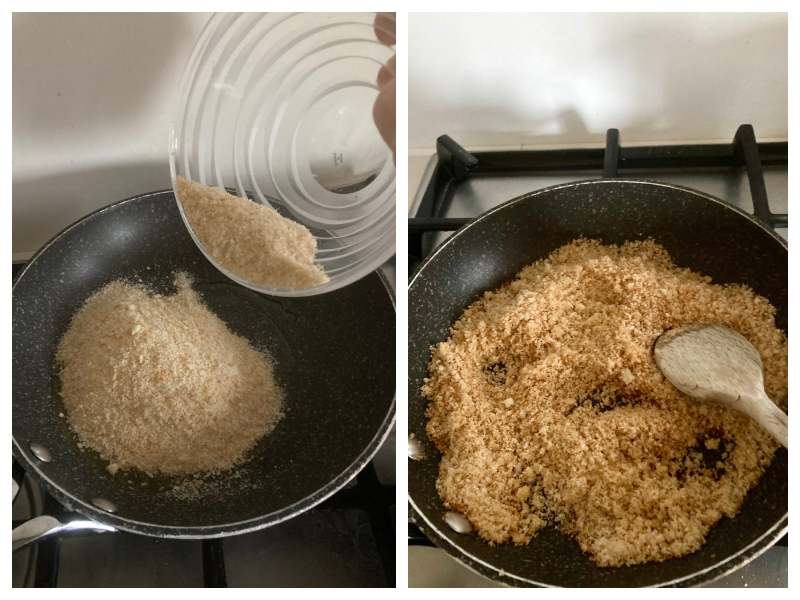
Step 8) - Now toast the breadcrumbs in a frying pan. Heat a 1 to 2 tablespoons of oil in the pan and add the breadcrumbs. Toast over medium heat.
Stir continuously so that the bread does not burn but becomes golden and crispy. This will take about 5 minutes. Keep aside.

Step 9) - Bring a large pot of salted water to a boil. Cook the spaghettoni - or bucatini - following the cooking time described on the package.
Drain the pasta 2 minutes before the end of cooking time. Place the pasta directly into the pan with the sauce.

Step 10) - Add a drizzle of oil and, if the sardine sauce has thickened too much in the meantime, add some of the fennel cooking water. Cook for 2 minutes over high heat, stirring gently without letting the sardines flake.
Serve the pasta hot with plenty of crunchy breadcrumbs.
Here is your Pasta con le Sarde! The authentic Sicilian recipe is ready!

YOU MUST ALSO TRY:
- Pasta with Eggplant and Swordfishis
- Pasta with Monkfish and Cherry Tomatoes
- Pasta alla Norma Recipe
- Sarde a Beccafico Recipe| Sicilian Stuffed Sardines
- Breaded Fried Anchovies Italian recipe
- Easy Italian Baked Sardines Recipe | Sarde al Forno
- Spaghetti with Anchovies and Breadcrumbs
Storage
It's better to eat Pasta con le Sarde freshly made, hot and with the toasted breadcrumbs still crispy.
In any case, should it be left over, you can store the Pasta con le Sarde tightly closed in a food container and keep it in the refrigerator for up to one day.
To reheat leftover the next day, there are two methods in Sicily.
- Pan-fried: you can pan-fry Pasta con le Sarde with a drizzle of oil.
- Baked: or put the Pasta con le Sarde in an baking pan. Sprinkle with a little breadcrumbs and add a drizzle of oil. Bake at 200°C (390°F) for 10 minutes.
Either way, the pasta will turn out crispy and golden. Although these are methods for not wasting leftovers, the result is really tasty and appetizing!

Variations
Pasta con le Sarde and wild fennel is a traditional dish from Palermo, but it is also prepared in Messina, Catania, Trapani, Syracuse, and Agrigento. As is the case with many traditional Italian recipes, each family has its own version and each has its own originality.
However, the basic ingredients are always the same in each variant: fresh sardines, wild fennel, raisins, pine nuts and breadcrumbs. In general, variations of Pasta con le Sarde fall into two main groups.
- Pasta con le sarde "in bianco" (white): that is, without tomato and with saffron.
- Pasta con le sarde "rossa" (red): thatis, with the addition of tomato.
The latter is more common in the Agrigento areas. Sometimes both tomato paste and saffron are added. In some areas, especially in the Trapani area, it's also common to add anchovies in oil to the onion soffritto.

"Pasta con le Sarde a Mare"
There is also a vegetarian variation: "Pasta con le Sarde a mare" (in the sea). This name comes from the sharp irony of the Sicilian people.
It's a dish belonging to the cucina povera of the past, prepared in times of "lean" in Sicily. When fishermen would return with empty nets.
Thanks to the presence of wild fennel, pine nuts, raisins and stale bread, the flavor is very reminiscent of that of traditional Pasta con le Sarde, only the sardines are not there, rather they are left "a mare" (in tha sea)!!!
Pasta di San Giuseppe
Although it's possible to cook this recipe year-round, Sicilians consider it a seasonal dish, to be eaten between March and September.
The freshness and territoriality of the two main ingredients (wild fennel and sardines) is crucial.
In the period between March and September, in the Sicilian highlands, the scented wild fennel can be harvested in abundance.
While the sea gives the best fresh sardines, larger and shinier, in great abundance at this time.
For this reason, Pasta con le Sarde is also called "Pasta di San Giuseppe." It's the typical dish that Sicilians use to cook on the day of St. Joseph, March 19.

History
According to some experts, the historical origins of Pasta con le Sarde date back to the time of the military campaign conducted by the Arabs near Syracuse in the early 9th century.
It was an Arab cook in the service of Commander Euphemius of Messina, head of the naval force of the Byzantine Empire, who invented this recipe.
During a military campaign in the Syracuse area, the cook allegedly created Pasta con le Sarde to feed his many troops.
The army was in dire straits, so the cook had to use his inventiveness to succeed in preparing a dish with what nature had to offer.
He used sardines, which were found in great abundance in that stretch of sea, and the flavors of the land, namely wild fennel and pine nuts.
Thus it was from this improvised preparation that Pasta con le Sarde was born.

Recipe Card

Pasta con le Sarde (Sicilian Pasta with Sardines)
Ingredients
- 350 g spaghettoni (thick spaghetti) or bucatini - 12 oz
- 250 g fresh sardines - 9 oz, cleaned and deboned
- 200 g wild fennel - 7 oz, if unavailable, substitute with fennel tops and a small pinch (less than 1 teaspoon) of fennel seeds.
- 1 small white onion
- 50 g raisins - 5 tablespoons
- 30 g pine nuts - 4 tablespoons
- 30 g almonds - 3 tablespoons
- 3 tablespoons extra virgin olive oil
- 0.15 g saffron
- 150 g breadcrumbs - 1 ½ cups
- black pepper - to taste
- salt - to taste
Instructions
- Boil the wild fennel. When the water boils, toss in the wild fennel - or fennel tops - and cook them over medium heat for 10 minutes.
- Once cooked, drain and chop them on a cutting board. Keep aside. Save the boiling water from the fennel.
- Soak the raisins in a small bowl of warm water. Keep aside. Then, on a cutting board, chop the onion quite finely and keep aside as well.
- Using an electric mixer, chop the almonds. It's not necessary to grind them into a powder, just chop them coarsely.
- Clean the sardines thoroughly. If your sardines are already cleaned, skip this step. Remove the head, tail, dorsal fin, guts and center bone.
- Finally, rinse them quickly under running water and dry them with paper towels. Arrange them on a plate and keep them aside.
- In a skillet, sauté the onion in extra virgin olive oil.
- Then add chopped fennel (and fennel seeds if you do not have wild fennel), raisins (squeezed out of water), chopped almonds and pine nuts and stir.
- Add a ladleful of the fennel cooking water and mix well. Let it cook for about 5 minutes on medium heat.
- Then dissolve the saffron in a tiny bit of water and add it to the sauce.
- Add the sardines. If they are large, cut them into pieces, otherwise put them whole.
- If necessary, add a little fennel cooking water so that the sardines turn out covered.
- Cook for about 5 or 6 minutes over medium heat. The sauce should be quite thick and the sardines not too flaky.
- Taste and add salt and pepper if necessary. Keep aside.
- Toast the breadcrumbs in a frying pan. Heat a 1 to 2 tablespoons of oil in the pan and add the breadcrumbs. Toast over medium heat.
- Stir continuously so that the bread does not burn but becomes golden and crispy. This will take about 5 minutes. Keep aside.
- Bring a large pot of salted water to a boil. Cook the spaghettoni - or bucatini - following the cooking time described on the package.
- Drain the pasta 2 minutes before the end of cooking time. Place the pasta directly into the pan with the sauce.
- Add a drizzle of oil and, if the sardine sauce has thickened too much in the meantime, add some of the fennel cooking water. Cook for 2 minutes over high heat, stirring gently without letting the sardines flake.
- Serve the pasta hot with plenty of crunchy breadcrumbs.

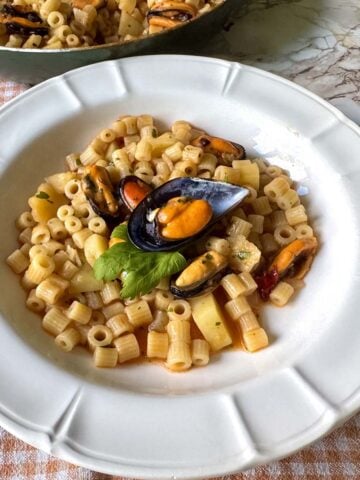
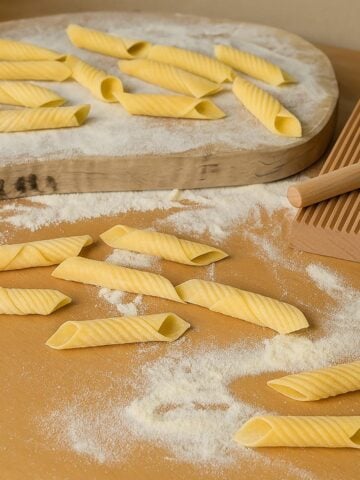
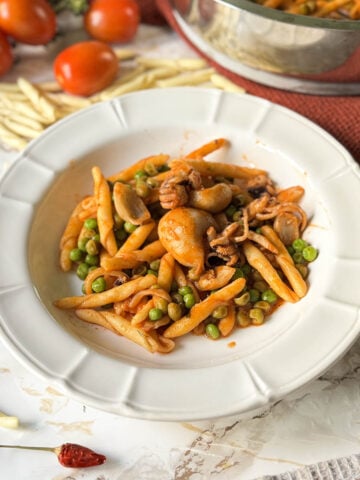
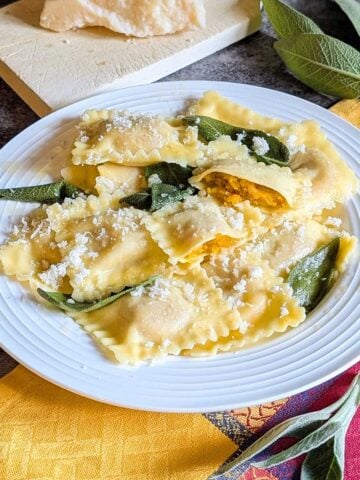
Leave a Reply